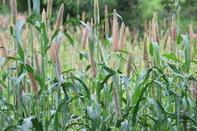Description and Origins
Pearl millet (Pennisetum glaucum) is a tall drought-tolerant grass growing up to 3 m in height with long blade-like leaves, extremely deep roots and bulrush-like seed heads.

The deep roots make the plant very drought-tolerant and hardy as it can access water from very deep under the soil surface. Pearl millet produces grain (seeds) for human consumption and the whole plant can be used as animal fodder.
It is believed to have originated in western regions of the Sahara desert in Africa about 4 000 years ago. It is also known as bulrush millet, manna (Afrikaans), leotsa (Sepedi), nyalothi (in Sesotho), inyouti (isiNdebele), mhuga, mhungu (Shangaan) or unyaluthi, unyawoti and unyawothi (isiZulu).
Pearl millet is SADC (Southern African Development Community) countries' third most important cereal grain in terms of production area, 0.9 million ha, with Namibia and Tanzania each accounting for about 27%.
The world's largest pearl millet producer is India with about 11 million tonnes produced annually (2014). It is mainly grown on a subsistence level in rural Southern Africa in hot dry regions with irregular rainfall patterns.
Uses of Pearl Millet
The decline of the cultivation of pearl millet, in favour of maize, is due to various factors: research efforts have made maize more productive than pearl millet and easier processing has made maize more convenient to use. This has resulted in maize often being cultivated in areas to which it is poorly suited and where it cannot perform.
In contrast, pearl millet yields reliably in regions too hot and too dry to consistently support good yields of maize (or even sorghum). There is the impression that pearl millet grain is mainly an animal feed, unsuitable for everyone except the starving.
This is wrong. Pearl millet is a versatile foodstuff that contains at least 9% protein, a range of amino acids and more oil than maize. It is also more digestible than sorghum as it contains no tannins, a bitter-tasting brown substance.
Pearl millet is used as a whole grain like rice, cracked or as a flour in rotis, in fermented foods, porridges, couscous, beverages and snacks. Pearl millet yields a gluten-free seed grain, high in energy but with a low glycemic index (low GI). It is high in fat, protein, iron, zinc and phosphorus (P) - P is very essential for bone growth.
The seeds can be eaten as a cooked grain, used to brew beer or ground into a flour. As an animal feed, pearl millet is grown to produce silage, hay or directly grazed when green.
As a fodder for animals, the seeds can be fed to poultry, the green plant used for grazing or used for silage and hay production. The dry plant material can also be used to weave baskets, for thatching and to build light fences.
By Marinda Louw